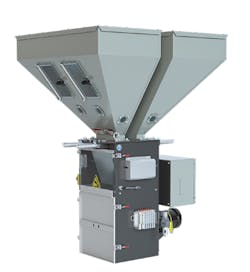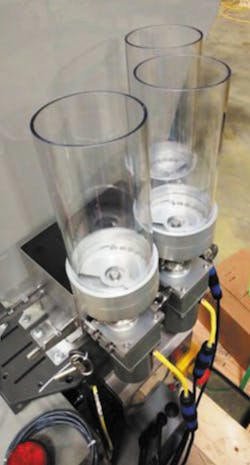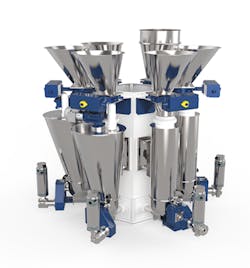Blenders make impact with advanced controls, dosing
New blending capabilities focusing on better operator controls, improved feedback and more precise dosing were on display at NPE2018 in Orlando, Fla.
The improved insight from new monitoring capabilities, as well as more accurate dosing, enable operators to more tightly regulate the amount of ingredients used, reduce waste and better control costs.
Manufacturers also offered blenders with smaller hoppers that can be dedicated to specific ingredients and allow for precise dosing. Additionally, with smaller hoppers, operators have lighter loads to lift.
ACS GROUP
When it came to launching its redesigned blenders, ACS Group wanted to leverage the reputation it had built with its BD series of batch-weight blenders, so the company didn't change the name when it relaunched the series with new features.
Units in the redesigned BD series are available with maximum blending rates ranging from 200 pounds per hour to 6,000 pounds per hour. They are suited for use with a wide range of processing machines, including extruders and injection, blow molding and rotomolding machines.
The upgraded blenders feature paddles with six fan-shaped blades that are designed to pull material from the corners, eliminating dead zones and waste, said Tony Johnson, product manager, materials-handling for ACS. Eliminating dead zones also helps the blenders achieve a homogeneous mixture four times faster than the industry average, he said.
"We did a side-by-side comparison" with the standard paddle, he said.
Johnson added that getting rid of dead zones helps customers achieve greater consistency across batches.
The blenders' HMI is seven times faster than the previous model. The new 7-inch touch screen features a graphical interface that is extremely user-friendly, Johnson said, enabling a new operator to run the machine like an expert. With the touch screen, the operator can load up to eight hoppers and control the conveyance of the material to the processing machine.
By tapping on various icons, the operator can see average batch time, the number of pounds being processed per hour, up to 100 unique recipes, the last batch's statistics and an alarm log. Multilevel password protection helps ensure machine security.
A redesigned slide gate enables users to dispense as few as five pellets at a time, ensuring precision dosing.
FOREMOST MACHINE BUILDERS
Foremost Machine Builders' new mini loss-in-weight blender, the MLWB VII AD, includes four ingredient chambers, each with a 0.6-cubic-foot capacity.
Part of the LWB VII AD series, the mini blender has a 60-pounds-per-hour throughput; larger blenders in the same family can handle up to 600 pounds per hour.
Each blender in the series offers the same features. By using four mini chambers rather than a single, larger chamber, the blender can more precisely dispense each ingredient. This is particularly important for customers who use expensive materials because it prevents waste and controls costs, assistant sales manager Drew Schmid said.
Another cost-saving feature is the dual-speed feeder controls. The first 90 to 95 percent of the material leaves the hopper at a customer-set speed, then the dispenser slows down to a slower "dribble rate," helping to ensure no ingredients are wasted.
New programmable controls include diagnostic screens that can monitor a single blender or several blenders at once. When the screen indicates a problem, it displays a question mark. Pressing the icon calls up the section of the blender manual that covers the specific component that needs attention. With this onboard manual, technicians have the repair information they need at their fingertips.
The blender's feeder trays also feature a 180-degree, quick-clean design, enabling a customer to quickly change from blending one ingredient to another. The blender also has connections for vacuum conveying. The blenders come in machine- and floor-mounted models.
The first of the blenders was installed in a customer facility in April.
ORBETRON
Disc-dosing offers precise control of the amount of ingredients a blender uses, helping to prevent wasted material and also providing consistent dosing of materials from batch to batch, said Roger Hultquist, Orbetron's co-founder and president of sales and marketing.
The company had sold disc feeders since 2011, but they were designed exclusively for use with Orbetron blenders. Earlier this year, the company introduced the ODC model, a blender that comes with disc feeders already installed.
Now, molding and extrusion companies that already have batch blenders from other makers but want the precision of disc dosing can buy a new OBB-R retrofit package, which includes disc feeders that are compatible with batch blenders from most manufacturers.
The disc feeders come in four sizes, featuring the 50, 100, 150 and 200 discs, named for the diameter of the discs as measured in millimeters. Each disc can have one to 50 holes to control dosing volume. The fewer holes, the smaller the dosing volume, which is important to companies using small injection molding machines. Typically, a company will use two of the disc feeders to replace two slide-gate feeders in a blender, Hultquist said. A company may also choose to replace all four slide-gate feeders with the disc feeders.
Another option is using the retrofit package to expand a four-station blender into a six-station blender, he said.
Other benefits of the retrofit package are that the disc-dosing design offers easy cleaning, quick material changeovers, high-temperature operation and the ability to use existing batch blender controls.
PLASTRAC
Plastrac's new touch-screen blender controls enable users to monitor their blenders from as far as 30 feet away, using an attached cord, President Kenneth Bullivant said. The compact control box is smaller, so it also offers users more options for placement compared to larger controllers.
The new touch-screen controllers were on display at NPE but will not be available to customers until later this year, Bullivant added. The controllers are for the company's entire line of blenders, which are suited for extrusion, injection molding and blow molding.
Another advantage is that it is much easier to train new users on the touch-screen controller than with the traditional, more complex, manual controls.
SYNCRO
Auxiliary equipment company Syncro presented its new C-multy line of gravimetric-feeding and blending stations, which is suitable for starve-fed extrusion using either single- or twin-screw extruders. The stations are modular and compatible with all feeders from Syncro's parent company, CSTControl, Busto Arsizio, Italy.
The components to be mixed are separately fed through a loss-in-weight continuous system into a common collecting hopper. The line includes the DS-4, which can handle a maximum of four components, the DS-6 with a maximum of six and the DS-8 with a maximum of eight.
According to the company, the stations provide accurate feeding of both free-flowing and non-free-flowing components. The system has an accuracy of within 0.03 percent and a capacity range of about 66 pounds to 2,645.5 pounds.
MAQUIRE + SYNCRO
Syncro and Maguire also introduced a new product configuration as part of a line of offerings known as Maguire + Syncro. Syncro is owned in part by Maguire, which offers the Maguire + Syncro products.
As part of the line, Maguire's WSB-2400 gravimetric blender is now offered with the optional addition of a C-twyn twin-screw feeding unit from Syncro. Maguire's blender can process as many as 12 ingredients and up to 8,000 pounds per hour. In the Maguire + Syncro configuration, a single motor drives the feed screws and horizontal agitator of Syncro's technology, preventing the material from bridging and maintaining constant flow.
With the C-twyn twin-screw feeding unit, the blender can process more materials, including hard-to-feed materials. The feeding unit optimizes the feeding of powder flow-control additives.
WITTMANN BATTENFELD
Wittmann Battenfeld's new gravimetric blenders, the Gravimax (GMX) G14 and the Gravimax (GMX) G34, are designed for customers that blend smaller amounts of material, said Nicholas Paradiso, division manager, materials handling and auxiliaries.
Each blender can handle up to four materials. The GMX G14 can handle batch sizes of 2.2 pounds, with an average throughput of 170 pounds per hour, while the GMX G34 can handle 6.6-pound batches and has an average throughput of 450 pounds per hour.
The blenders offer a two-stage metering process using algorithms, so the ingredients will fill the hopper quickly until they reach an operator-specified level, such as 90 to 95 percent, then much more slowly after that to prevent overfilling and spillage.
Users can simply lift the lids for either blender for easy cleaning, Paradiso added. And, they can easily change the small hoppers to swap from one ingredient to another. So rather than dumping bags of ingredients into larger hoppers, which tends to raise more fine dust, users can instead dedicate the smaller hoppers of these smaller blenders for specific ingredients, preventing dust and reducing cleaning time.
The blenders also have the option of a tilted loader, which provides more flexibility and ease of use than a standard loader. The tilted loader also provides improved ergonomics.
The new blenders use the same RTLS (real-time live-scale) technology as other Wittmann Battenfeld blenders so that the operator can set percentages to the required minimum level to ensure batch-to-batch accuracy.
Some of the other features of the new blenders include the ability to store 500 recipes in the database and a USB interface.
Like older Wittmann Battenfeld blenders, the newer ones use a Net8 blender control with Wittmann 4.0 interfaces. The touch screen gives operators access to cycle and total run, inventory reports and recipe-maintenance information, as well as the ability to change recipes and parameters without stopping production.
ADVANCED BLENDING SOLUTIONS
Advanced Blending Solutions introduced its new sound enclosures, which are available as an option on new vacuum and pressure pumps, and as a retrofit. The pumps are used to convey material to the blender. The sound enclosures dampen sound to below 85 decibels at a distance of 3 feet.
Access points to drain and fill oil, the VFD interface and the vacuum level gauge are available from outside the enclosures, the company said. To access the belt, an operator simply needs to remove a panel; the panel has a quarter-turn lock for safety. The enclosures have improved airflow and a direct-drive belt for less slipping and increased output.
Phillip Britt, correspondent
Contact:
ACS Group, New Berlin, Wis., 262-641-8600, www.acscorporate.com
Advanced Blending Solutions LLC, Wallace, Mich., 906-914-4180, www.adv-blend.com
Foremost Machine Builders Inc.,
Fairfield, N.J., 973-227-0700,www.foremostmachine.com
Maguire Products Inc.,
Aston, Pa., 610-459-4300,www.maguire.com
Orbetron LLC, Cumberland, R.I., 856-472-0268, www.orbetron.com
Plastrac Inc.,
Edgemont, Pa., 610-356-3000,www.plastrac.com
Syncro USA, Antioch, Ill., 888-778-9804, www.syncrousa.net
Wittmann Battenfeld Inc.,
Torrington, Conn., 860-496-9603,www.wittmann-group.com



